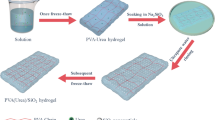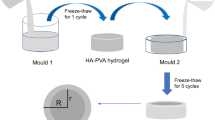Abstract
Polyvinyl alcohol (PVA) hydrogels as alternative materials for biomedical applications have attracted extensive attention. However, the development of bioactive hydrogel with macroporous structure and good mechanical performance is still an enormous challenge. In this study, a PVA-tannic acid (TA) macroporous hydrogel is presented by cryogelation method. The macropores are obtained by the large-sized ice crystals generated in situ. The pore size of the obtained hydrogel could reach 150–250 μm and the porosity is over 85%. The macroporous PVA-TA hydrogel exhibit notable compressive modulus (0.54 MPa), tensile modulus (0.70 MPa), compressive toughness (1.14 MJ/m3) and tensile toughness (1.49 MJ/m3). In addition, the hydrogel has remarkable self-recovery and energy dissipation ability. From the in vitro cell culture, it is observed that TA has strongly enhanced the bioadhesion and bioactivity of hydrogel, implying the potential application of PVA-TA hydrogel in cartilage replacement.
Graphical abstract





Similar content being viewed by others
References
Wei W, Ma Y, Yao X et al (2021) Advanced hydrogels for the repair of cartilage defects and regeneration. Bioact Mater 6:998–1011. https://doi.org/10.1016/j.bioactmat.2020.09.030
Almarza AJ, Athanasiou KA (2004) Design characteristics for the tissue engineering of cartilaginous tissues. Ann Biomed Eng 32:2–17. https://doi.org/10.1023/B:ABME.0000007786.37957.65
Wei W, Dai H (2021) Articular cartilage and osteochondral tissue engineering techniques: recent advances and challenges. Bioactive Materials 6:4830–4855. https://doi.org/10.1016/j.bioactmat.2021.05.011
Baker MI, Walsh SP, Schwartz Z, Boyan BD (2012) A review of polyvinyl alcohol and its uses in cartilage and orthopedic applications. J Biomed Mater Res B Appl Biomater 100B:1451–1457. https://doi.org/10.1002/jbm.b.32694
Sardinha VM, Lima LL, Belangero WD, Zavaglia CA, Bavaresco VP, Gomes JR (2013) Tribological characterization of polyvinyl alcohol hydrogel as substitute of articular cartilage. Wear 301:218–225. https://doi.org/10.1016/j.wear.2012.11.054
Oliveira AS, Seidi O, Ribeiro N, Colaco R, Serro AP (2019) Tribomechanical comparison between PVA hydrogels obtained using different processing conditions and human cartilage. Materials (Basel). https://doi.org/10.3390/ma12203413
Zhang Q, Lu H, Kawazoe N, Chen G (2014) Pore size effect of collagen scaffolds on cartilage regeneration. Acta Biomater 10:2005–2013. https://doi.org/10.1016/j.actbio.2013.12.042
Timothy KL, Henderson MA, Haylock DN, McLean KM, O’Connor AJ (2013) Cryogels for biomedical applications. J Mater Chem B 1:2682–2695. https://doi.org/10.1039/c3tb20280a
Congdon T, Notman R, Gibson MI (2013) Antifreeze (glyco)protein mimetic behavior of poly(vinyl alcohol): detailed structure ice recrystallization inhibition activity study. Biomacromolecules 14:1578–1586. https://doi.org/10.1021/bm400217j
Wang HY, Inada T, Funakoshi K, Lu SS (2009) Inhibition of nucleation and growth of ice by poly(vinyl alcohol) in vitrification solution. Cryobiology 59:83–89. https://doi.org/10.1016/j.cryobiol.2009.04.013
Gutiérrez MC, García-Carvajal ZY, Jobbágy M et al (2007) Poly(vinyl alcohol) scaffolds with tailored morphologies for drug delivery and controlled release. Adv Func Mater 17:3505–3513. https://doi.org/10.1002/adfm.200700093
Jiang S, Liu S, Feng W (2011) PVA hydrogel properties for biomedical application. J Mech Behav Biomed Mater 4:1228–1233. https://doi.org/10.1016/j.jmbbm.2011.04.005
Hou R, Nie L, Du G, Xiong X, Fu J (2015) Natural polysaccharides promote chondrocyte adhesion and proliferation on magnetic nanoparticle/PVA composite hydrogels. Coll Surf B Biointerf 132:146–154. https://doi.org/10.1016/j.colsurfb.2015.05.008
Jiang X, Xiang N, Zhang H, Sun Y, Lin Z, Hou L (2018) Preparation and characterization of poly(vinyl alcohol)/sodium alginate hydrogel with high toughness and electric conductivity. Carbohydr Polym 186:377–383. https://doi.org/10.1016/j.carbpol.2018.01.061
Qi X, Hu X, Wei W et al (2015) Investigation of Salecan/poly(vinyl alcohol) hydrogels prepared by freeze/thaw method. Carbohydr Polym 118:60–69. https://doi.org/10.1016/j.carbpol.2014.11.021
Li H, C-w Wu, Wang S, Zhang W (2020) Mechanically strong poly (vinyl alcohol) hydrogel with macropores and high porosity. Mater Lett 266:127504. https://doi.org/10.1016/j.matlet.2020.127504
Ma S, Lee H, Liang Y, Zhou F (2016) Astringent mouthfeel as a consequence of lubrication failure. Angew Chem Int Ed 55:5887–5891. https://doi.org/10.1002/anie.201601667
Yang S, Zhang Y, Wang T, Sun W, Tong Z (2020) Ultrafast and programmable shape memory hydrogel of gelatin soaked in tannic acid solution. ACS Appl Mater Interf 12:46701–46701. https://doi.org/10.1021/acsami.0c13531
Fan H, Wang J, Jin Z (2018) Tough, swelling-resistant, self-healing, and adhesive dual-cross-linked hydrogels based on polymer-tannic acid multiple hydrogen bonds. Macromolecules 51:1696–1705. https://doi.org/10.1021/acs.macromol.7b02653
Chang M, Liu X, Wang X, Peng F, Ren J (2021) Mussel-inspired adhesive hydrogels based on biomass-derived xylan and tannic acid cross-linked with acrylic acid with antioxidant and antibacterial properties. J Mater Sci 56:14729–14740. https://doi.org/10.1007/s10853-021-06228-y
Zhang R, Ma PX (1999) Poly (α-hydroxyl acids)/hydroxyapatite porous composites for bone-tissue engineering i preparation and morphology. J Biomed Mater Res 44(4):446–455. https://doi.org/10.1002/(SICI)1097-4636(19990315)44:4%3c446::AID-JBM11%3e3.0.CO;2-F
Han G, Shao H, Zhu X et al (2012) The protective effect of xanthan gum on interleukin-1beta induced rabbit chondrocytes. Carbohydr Polym 89:870–875. https://doi.org/10.1016/j.carbpol.2012.04.023
Bai Z, Wang T, Zheng X, Huang Y, Chen Y, Dan W (2020) High strength and bioactivity polyvinyl alcohol/collagen composite hydrogel with tannic acid as cross-linker. Polym Eng Sci 61:278–287. https://doi.org/10.1002/pen.25574
Dai H, Huang Y, Huang H (2018) Enhanced performances of polyvinyl alcohol films by introducing tannic acid and pineapple peel-derived cellulose nanocrystals. Cellulose 25:4623–4637. https://doi.org/10.1007/s10570-018-1873-5
Pretsch E, Buehlmann P, Affolter C, Pretsch E, Bhuhlmann P, Affolter C (2000) Structure determination of organic compounds. Springer. https://doi.org/10.1007/978-3-662-62439-5
Zhang W, Dehghani-Sanij AA, Blackburn RS (2008) IR study on hydrogen bonding in epoxy resin–silica nanocomposites. Prog Nat Sci 18:801–805. https://doi.org/10.1016/j.pnsc.2008.01.024
Peng M, Xiao G, Tang X, Zhou Y (2014) Hydrogen-bonding assembly of rigid-rod poly(p-sulfophenylene terephthalamide) and flexible-chain poly(vinyl alcohol) for transparent, strong, and tough molecular composites. Macromolecules 47:8411–8419. https://doi.org/10.1021/ma501590x
Wang F, Wen Y, Bai T (2016) The composite hydrogels of polyvinyl alcohol-gellan gum-Ca(2+) with improved network structure and mechanical property. Mater Sci Eng C Mater Biol Appl 69:268–275. https://doi.org/10.1016/j.msec.2016.06.084
Heneghan AF, Haymet ADJ (2003) Liquid-to-crystal heterogeneous nucleation: bubble accelerated nucleation of pure supercooled water. Chem Phys Lett 368:177–182. https://doi.org/10.1016/s0009-2614(02)01835-3
Milner PE, Parkes M, Puetzer JL et al (2018) A low friction, biphasic and boundary lubricating hydrogel for cartilage replacement. Acta Biomater 65:102–111. https://doi.org/10.1016/j.actbio.2017.11.002
Zhang S, Li Y, Zhang H et al (2021) Bioinspired conductive hydrogel with ultrahigh toughness and stable antiswelling properties for articular cartilage replacement. ACS Mater Lett 3(6):807–814. https://doi.org/10.1021/acsmaterialslett.1c00203
Chang C, Peng N, He M, Teramoto Y, Nishio Y, Zhang L (2013) Fabrication and properties of chitin/hydroxyapatite hybrid hydrogels as scaffold nano-materials. Carbohydr Polym 91:7–13. https://doi.org/10.1016/j.carbpol.2012.07.070
Fan X, Wang S, Fang Y et al (2020) Tough polyacrylamide-tannic acid-kaolin adhesive hydrogels for quick hemostatic application. Mater Sci Eng C Mater Biol Appl 109:110649. https://doi.org/10.1016/j.msec.2020.110649
Gan D, Wang Z, Xie C et al (2019) Mussel-inspired tough hydrogel with in situ nanohydroxyapatite mineralization for osteochondral defect repair. Adv Healthc Mater 8:e1901103. https://doi.org/10.1002/adhm.201901103
Chang KH, Liao HT, Chen JP (2013) Preparation and characterization of gelatin/hyaluronic acid cryogels for adipose tissue engineering: in vitro and in vivo studies. Acta Biomater 9:9012–9026. https://doi.org/10.1016/j.actbio.2013.06.046
Sedlačík T, Nonoyama T, Guo H et al (2020) Preparation of tough double- and triple-network supermacroporous hydrogels through repeated cryogelation. Chem Mater 32:8576–8586. https://doi.org/10.1021/acs.chemmater.0c02911
Yue Y, Wang X, Wu Q, Han J, Jiang J (2020) Highly recyclable and super-tough hydrogel mediated by dual-functional TiO2 nanoparticles toward efficient photodegradation of organic water pollutants. J Coll Interf Sci 564:99–112. https://doi.org/10.1016/j.jcis.2019.12.069
Su T, Liu Y, He H et al (2016) Strong bioinspired polymer hydrogel with tunable stiffness and toughness for mimicking the extracellular matrix. ACS Macro Lett 5:1217–1221. https://doi.org/10.1021/acsmacrolett.6b00702
Danso EK, Honkanen JT, Saarakkala S, Korhonen RK (2014) Comparison of nonlinear mechanical properties of bovine articular cartilage and meniscus. J Biomech 47:200–206. https://doi.org/10.1016/j.jbiomech.2013.09.015
Zhang X, Li Z, Yang P et al (2021) Polyphenol scaffolds in tissue engineering. Mater Horiz 8:145–167. https://doi.org/10.1039/d0mh01317j
Liskova J, Douglas TE, Beranova J et al (2015) Chitosan hydrogels enriched with polyphenols: antibacterial activity, cell adhesion and growth and mineralization. Carbohydr polym 129:135–142. https://doi.org/10.1016/j.carbpol.2015.04.043
Natarajan V, Krithica N, Madhan B, Sehgal PK (2013) Preparation and properties of tannic acid cross-linked collagen scaffold and its application in wound healing. J Biomed Mater Res B Appl Biomater 101:560–567. https://doi.org/10.1002/jbm.b.32856
Acknowledgements
This work was supported by National Key R&D Project of China (2018YFA0704103, 2018YFA0704104), National Natural Science Foundation China (11772086, U1908233), and Fundamental Research Funds for the Central Universities (DUT21TD105).
Author information
Authors and Affiliations
Corresponding author
Ethics declarations
Conflict of interest
The authors declare that they have no conflict of interest.
Additional information
Handling Editor: Maude Jimenez.
Publisher's Note
Springer Nature remains neutral with regard to jurisdictional claims in published maps and institutional affiliations.
Supplementary Information
Below is the link to the electronic supplementary material.
Rights and permissions
About this article
Cite this article
Li, H., Li, J., Li, T. et al. Macroporous polyvinyl alcohol-tannic acid hydrogel with high strength and toughness for cartilage replacement. J Mater Sci 57, 8262–8275 (2022). https://doi.org/10.1007/s10853-022-07209-5
Received:
Accepted:
Published:
Issue Date:
DOI: https://doi.org/10.1007/s10853-022-07209-5




